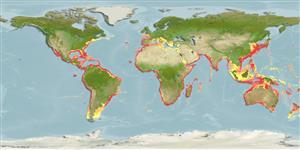Classification / Names
Common names from other countries
Référence principale
Taille / Poids / Âge
Max length : 234 cm TL mâle / non sexé; (Ref. 26340); common length : 100.0 cm TL mâle / non sexé; (Ref. 26999); poids max. publié: 5.0 kg (Ref. ); âge max. reporté: 15 années (Ref. 7142)
Length at first maturity
Lm 46.3, range 30 - 99 cm
Environnement
; marin; saumâtre benthopélagique; amphidrome (Ref. 51243); profondeur 0 - 589 m (Ref. 58018), usually 100 - 350 m (Ref. 35388)
Climat / Gamme
Subtropical, preferred 26°C (Ref. 107945); 49°N - 54°S, 114°W - 180°E (Ref. 54931)
Distribution
Circumtropical and temperate waters of the world. Trichiurus japonicus which was originally described from Japan as Trichiurus lepturus japonicus was synonymized with Trichiurus lepturus. Another nominal species synonymized with Trichiurus lepturus is Trichiurus nitens from the eastern Pacific Ocean (California to Peru).
Pays | Zones FAO | Écosystèmes | Occurrences | Introductions
Description synthétique
Épines dorsales (Total): 3; Rayons mous dorsaux (Total): 130-135; Rayons mous anaux: 100 - 105. Body extremely elongate, compressed and tapering to a point. Mouth large with a dermal process at the tip of each jaw. Dorsal fin relatively high; anal fin reduced to minute spinules usually embedded in the skin or slightly breaking through; anterior margin of pectoral fin spine not serrated. Pelvic and caudal fins absent. Lateral line beginning at the upper margin of the gill cover, running oblique to behind the tip of the pectoral fins, then straight close to the ventral contour. Fresh specimens steely blue with silvery reflections, becoming uniformly silvery gray sometime after death (Ref. 6181).
Statut dans la liste rouge de l'IUCN (Ref. 115185)
Menace pour l'homme
Harmless
Utilisations par l'homme
Pêcheries: hautement commercial; pêche sportive: oui
Outils
Articles particuliers
Télécharger en XML
Sources Internet
Estimates of some properties based on models
Phylogenetic diversity index
PD50 = 0.5020 many relatives (e.g. carps) 0.5 - 2.0 few relatives (e.g. lungfishes)
Niveau trophique
4.4 ±0.4 se; Based on diet studies.
Résilience
Milieu, temps minimum de doublement de population : 1,4 à 4,4 années (K=0.25-0.29; tm=2; tmax=15)
Vulnérabilité
Moderate to high vulnerability (51 of 100)
Catégorie de prix
